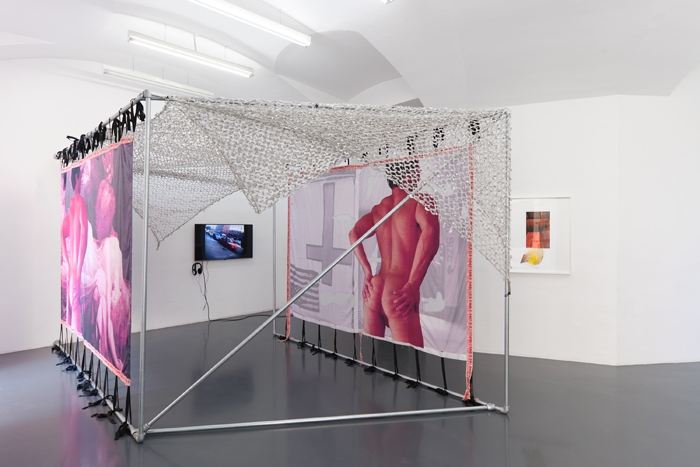In Michael Curran’s 1994 film Amami Se Vuoi, the artist lies down naked on a table. He smokes a cigarette gauntly, and asks someone off screen to cue the titular ballad. Another man, muscled and clothed this time, leans over him and proceeds to methodically spit into his mouth until the song ends. Details register blurrily and woozily: arm hair in the light, a ball necklace reminding the viewer that gravity still exists even as Curran strains upwards. Watching this short feels like being surprised by bits of eggshell in your soft-boiled egg. Tenderness, violence, followed by nervy duende.
The men are enacting a fantasy culled from Jean Genet’s 1946 novel Miracle of the Rose, previously editorialised in the closing scenes of Todd Haynes’s 1991 film Poison. While both interpretations share a certain ecstatic quality, a sense of transcendence via transgression, Curran’s is quieter, and far less exuberant. How does it end? Biceps straightens himself out of frame, leaving Bony with a half erection. It’s one of the most extraordinary works I’ve ever seen.
Limp, curated by Paul Clinton (as part of Vienna’s ‘Curated by’ festival) and featuring seven artists or collectives, is full of such moments of interrupted circulation that deftly circumvent both sentiment and cheap thrills. To the treacly liberal adage that ‘love is love’, it offers the noncommittal titles of Curran’s aforementioned work (which translates as ‘love me if you want’), and disappointment (1994/2019), a fleece printed with a portrait of a man flung over a chair. At its core is the pertinent question of whether framing queer imagery as transgressive operates to silo sexual minorities. Or does it keep the straights safely out?
This tension is made literal in Richard John Jones’s The Nightmare Having A Nightmare (After Ingo Swann) (2017), which greets the viewer at the show’s outset. Banners featuring bare-assed men, and the odd upside-down cross or American flag, are tied to a steel scaffolding structure draped with camouflage netting. The banners are bordered by thin strips featuring phrases repeating like ticker tape, such as ‘without a reflection I cease to exist’. Crucially, the libidinal frustration extends to the artists too. If Jones’s structure suggests the frisson of public voyeurism, Liz Rosenfeld’s video liz/james/stillholes (2005/2017) on a nearby wall provides some contrast. The artist tries to cruise porn-shop glory holes, is denied on account of being a woman but tries to sneak in anyway, opining on gender with her interlocutor and the differences between lesbian and gay culture along the way. “Judith Butler is sitting in the car with me right now! Judith!” she shrieks playfully at one point, before grousing that “gay men are so afraid of their culture being taken away from them”.
Perhaps we all understand – at least on some level – that representation is not the same thing as reparation or transformative justice, and that neoliberalism has all but neutered its radical potential. But while the mainstream might have snatched culture, there’s always history, seen here in some early General Idea works, and a compelling vitrine of queer-theory texts.
Still, the works in this show are sexy without ever becoming a spectacle. Even when they gently mock these boundaries through humour, as with the smorgasbord of winky beefcakes in Robert Blanchon’s supercut let’s just kiss + say goodbye (1995), it’s all innuendo and no action. Projected large against one gallery wall, the video features a parade of masculine archetypes-cum-fantasies: doctor, sailor, cowboy, guy-next-door and so on. Each encounter is cut short. Coupled with the schmaltzy soundtrack, it serves as a sobering reminder of the aids epidemic, which casts its long shadow over the show as a whole. But viewed today in the age of streaming services, it equally suggests scrolling or flipping through categories of porn. Just horny and bored; nothing to see here.
Limp at Galerie Emanuel Layr, Vienna 13 September – 31 October
From the December 2019 issue of ArtReview
